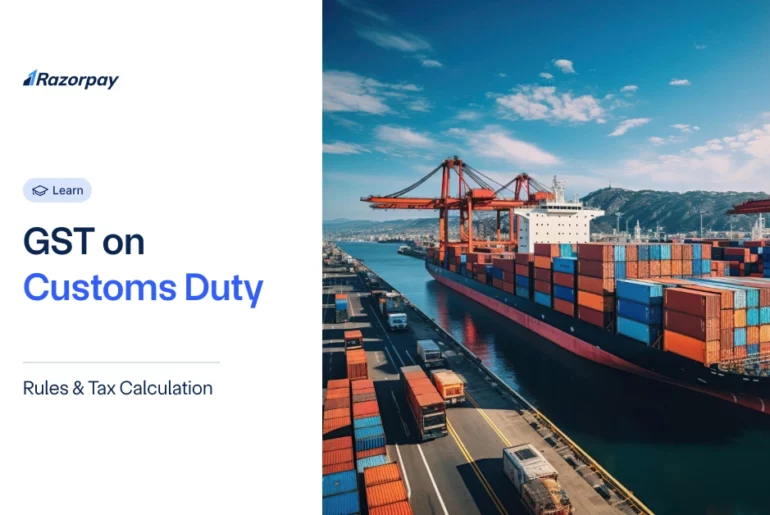GST and customs duty are two integral components of India’s tax system that impact businesses engaged in international trade. Understanding how these taxes interact and calculating them accurately is crucial for compliance and cost management. This article breaks down the key rules and calculation methods for GST on custom duty, helping you navigate the complexities with ease.
Table of Contents
Customs Duty on Imports
When goods are imported into India, they are subject to customs duty. This duty is levied by the Central Government under the Customs Act, 1962. The applicable duty rates depend on the product classification as per the Harmonized System of Nomenclature (HSN) and the Customs Tariff Act.
Here are some key points to note about customs duty on imports:
- Basic Customs Duty (BCD) is levied as a percentage of the assessable value, which includes the transaction value, freight, insurance, and other charges up to the port of importation.
- The standard rate of BCD is 10%, but it can vary for different products.
- In addition to BCD, imports may also attract other duties and cesses such as:
- Social Welfare Surcharge (10% of BCD)
- IGST on custom duty (levied on the total of assessable value plus BCD plus Social Welfare Surcharge)
- Compensation Cess (applicable on certain products)
Revised Customs Duty Rates
The government periodically revises customs duty rates to protect domestic industries, promote local manufacturing, or align with trade agreements. Here are some recent changes in duty rates across various sectors:
1. Impact on the Electronics Industry
- Customs duty on imported parts for mobile phone chargers increased from 10% to 20% to encourage domestic production.
- Duty on printed circuit board assembly (PCBA) for mobile phones reduced from 10% to 5% to promote local manufacturing.
2. Changes for Essential Goods
- Basic customs duty exempted on imports of certain medical supplies and equipment to combat the COVID-19 pandemic.
- Duty on the import of raw cotton was reduced from 10% to 5% to support the textile industry.
3. Updates for the Medical Sector
- Customs duty exempted on imports of life-saving drugs and medicines, subject to certain conditions.
- Concessional rate of 5% BCD was extended on certain medical devices to encourage domestic manufacturing.
Customs Duty on Leather and Textiles
The leather and textile industries are important sectors of India’s economy. Here’s how customs duty applies to these sectors:
- Raw hides and skins attract a basic customs duty of 5%.
- Finished leather products have a higher duty rate of 10-20% to protect domestic manufacturers.
- Customs duty on imported textile machinery is 7.5% to support the modernization of the textile industry.
Other Sectors Affected by Customs Duty
Apart from electronics, essentials, medical supplies, leather, and textiles, several other sectors are impacted by changes in customs duty rates:
- Automotive: Customs duty on imported electric vehicles increased to 40% to promote domestic manufacturing under the “Make in India” initiative.
- Chemicals: Duty on certain petrochemicals and specialty chemicals was reduced to 2.5% to make them more competitive.
- Agriculture: Basic customs duty on the import of certain pulses and edible oils increased to protect domestic farmers.
GST on Imports and Exports: How It Works
In addition to customs duty, GST is also levied on imports and exports. Let’s understand how it works:
1. GST on Imports
Taxation on Imported Goods
- GST on imported goods is levied in the form of Integrated GST (IGST).
- IGST is calculated on the value of imported goods plus any customs duty (BCD + Social Welfare Surcharge).
- The standard rate of IGST is 18%, but it can vary based on the GST rates applicable to different products.
GST Rules for Imported Services
- Import of services is treated as inter-state supply and subject to IGST
- The importer is required to pay IGST under the reverse charge mechanism
- Imported services used for personal consumption are not eligible for input tax credit
2. GST on Exports
- Exports are considered as zero-rated supplies under GST
- Exporters can choose to export goods or services under Bond/LUT (Letter of Undertaking) without paying IGST
- Alternatively, exporters can pay IGST on exports and claim a refund later
- Input tax credit can be claimed on inputs used for making export supplies
Frequently Asked Questions (FAQs):
1. What is the difference between GST and Customs Duty?
GST is a comprehensive indirect tax levied on the supply of goods and services, while customs duty is a tax imposed on the import of goods into India. Customs duty is levied by the Central Government, whereas GST is administered by both the Central and State Governments.
2. Are imported goods subject to both GST and Customs Duty?
Yes, imported goods attract both IGST (Integrated GST) and customs duties like Basic Customs Duty (BCD).
3. What is the role of the Bill of Entry in GST on imports?
The Bill of Entry is a legal document filed by the importer declaring the exact nature, quantity, and value of goods. It is used to calculate igst on customs duty and must be submitted to customs authorities.
4. How are GST refunds processed on imports?
Importers can claim a refund of IGST paid on imports by filing a refund application in Form GST RFD-01A. The refund is credited to the importer’s bank account.
5. What documents are required to pay GST and customs duty on imports?
To pay GST and customs duty on imports, the following documents are required:
- Bill of Entry
- Invoice
- Packing List
- Bill of Lading/Airway Bill
- Certificate of Origin (if applicable)
- Other product-specific certificates or permits
6. How can businesses avoid penalties for incorrect customs duty payments?
To avoid penalties:
- Ensure accurate product classification and valuation
- Keep up-to-date with changes in duty rates and exemptions
- Maintain proper documentation
- Seek professional guidance when needed
7. Are there exemptions available for customs duty and GST on certain imports?
Yes, exemptions or concessions may be available for certain goods under trade agreements, export promotion schemes, or special notifications issued by the government.



